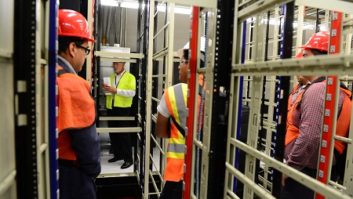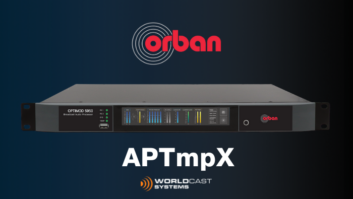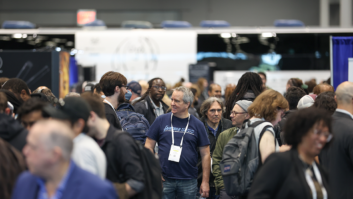The radio broadcast industry has entered what some might term a golden age of processing. Relatively inexpensive but powerful processing chips along with an ever-increasing supply of processing algorithms look to have created the perfect processor storm.
But, to pinch Spiderman, with great power comes great responsibility; and some would argue that an overdependency on processors has created a situation wherein overprocessing is as bad as underprocessing.

Left: Bob Orban, shown at the 2011 NAB Show. Photo by Jim Peck; Right: Bob Orban and John Delantoni demo an Optimod-AM 9000 prototype at the NAB convention in 1977. Is this too much of a good thing?
One of the highlights of the AES show in New York, Oct. 20–23, will be a panel on the topic of “Audio Processing for Radio.” On the panel, moderated by Cox Radio’s Steve Fluker, will be two names familiar to anyone involved in radio processing, Bob Orban of Orban and Frank Foti of Omnia Audio.
Fluker commented on getting two processor legends back on the same stage: “Both bring a world of knowledge and experience to our audience. Bob has been an innovator in processing making radio work for the audience, while Frank comes from the broadcast engineering side of the business and knew what programmers and listeners wanted and met those needs and met them well.
“The competition between the two companies has resulted in the broadcast world winning.”
Under or over?
For broadcast engineers, “processing” is similar yet different than “processing” in a recording studio.
“Radio stations have been processing their signals for decades,” Foti said. “Broadcasters employ processing to create an over-the-air signature sound, along with ensuring they do not overmodulate the transmitter. The psychology behind audio processing runs the full gamut. Some employ processing in order to offer a balance between quality and loudness. Others may choose loudness as the most important, and there’s a school of thought to always provide the best quality possible.
“It really comes down to the philosophy behind the business model of the particular radio station.”
Bob Orban said, “In all transmission systems, AM, FM, netcasting, processing smoothes out differences between program elements, making transitions sound graceful and limiting dynamic range so that the broadcast can easily be enjoyed in typical listening environments, which often have substantial background noise. Multiband processing smoothes out both loudness variations and spectral balance variations between sources. In AM radio, processing improves the coverage area of the station by raising the program material above the RF noise. This is less true for FM and not at all a factor in netcasting.”

Left: Frank Foti. Photo by Jim Peck; Right: Engineer of a different stripe, Frank Foti, train buff, in 2006. One of the motivations of the panel is the question of “overprocessing.” Says Fluker: “Overprocessing in my opinion is never a good thing. There can be a fine line, though, between finding that sweet spot in processing and sounding bad. Too much processing can drive your audience away by causing listener fatigue. Many times the listener to an overprocessed radio station can hit the button and change stations and not really know why. They are just tired of listening.”
Foti zeroes in on intermodulation distortion: “When radio becomes overprocessed, what is actually perceived is the buildup of IMD as created by the processor itself. Much of this usually occurs when the device is pushed, or setup for loudness, at all costs.”
He feels that modern technology is coming to the rescue: “We’ve put a number of years into research about this very topic. The results are new algorithms designed to reduce the effect of sounding overprocessed, yet being able to maintain competitive loudness.”
Orban said, “Processing should always be matched to the format and preferences of the target audience. This requires research and/or experience. In general, audiences tend to complain more about underprocessing, which makes the broadcast difficult to listen to because of inconsistent loudness and/or excessive RF channel-induced noise, than by overprocessing, which typically damages the dynamic punch of the program material and which may induce overt raspy or grainy distortion.”
Orban describes his processing philosophy as “The customer is always right. That is, although I have my own preferences and find many of today’s ‘hypercompressed’ CDs to be unlistenable, it is not my job to second-guess program directors or other station personnel whose job it is to tailor the sound of their broadcast to their target audience.”
He adds, “Secondarily, I believe that it is better to expect processors to do a few things well than to try to do things automatically that should be done in the production studio, with the risk of doing such things badly and in an unpredictable, program-dependent way.”
Within the last two years, Orban, Omnia and others including Wheatstone and Inovonics have launched new “flagship” digital processors in a wave of product releases. More affordable digital technology enhanced with investments in algorithm development have made powerful processing boxes available at what might be considered “affordable” pricing. That has not gone unnoticed.
“I think today’s processors have a lot of advantages,” Fluker said.
If You Go
What: 131st Audio Engineering Society Convention
Where: Jacob Javits Convention Center, New York
When: Oct. 19–23 (exhibits Oct. 21–23)
How Much: $509 (non-member, full program, advance order) “First of all, by using new and powerful DSPs, we are able to achieve sounds and high-quality processed audio that was never achievable in the past. Newer processors also allow ease of setup for engineers and programmers through presets and easy adjustments. Yet the advanced user now has the ability to get in and ‘micromanage’ the processor.
“I do caution people that if you start getting into the advanced settings that it can be easy to create a monster and something that sounds horrible.”
Another caveat might be that of diminishing returns. Orban suggests we’ve reached that point. “Making significant audible improvements is getting more and more difficult because of the relative maturity of the processing art in the year 2011.”
Yet he too eagerly awaits the latest from behind the research lab curtain. When asked what’s next on the processing front, he simply responds, coyly, “That would be telling …”
Looking to the future of processing, when asked what else there is for processors to do, Foti responds: “Plenty. We are now able to reduce perceived distortion via new algorithms that control intermodulation distortion, probably the biggest annoyance to radio listening. Also, we can employ processing to add robustness to ancillary signals like the watermarked Arbitron PPM codes. Additionally, we designed new dynamic algorithms that employ acceleration and deceleration methods which make sure the dynamic processing sections get the level properly adjusted correctly, all the time. This is really the secret sauce in how quality and loudness can occur together.”
Fluker, Foti and Orban will be joined on the panel by Jim Hoge of WPOZ(FM) and consultant James J. Johnston. The AES session “Audio Processing for Radio” takes place Friday Oct. 21 from 9 to 10:30 a.m.












